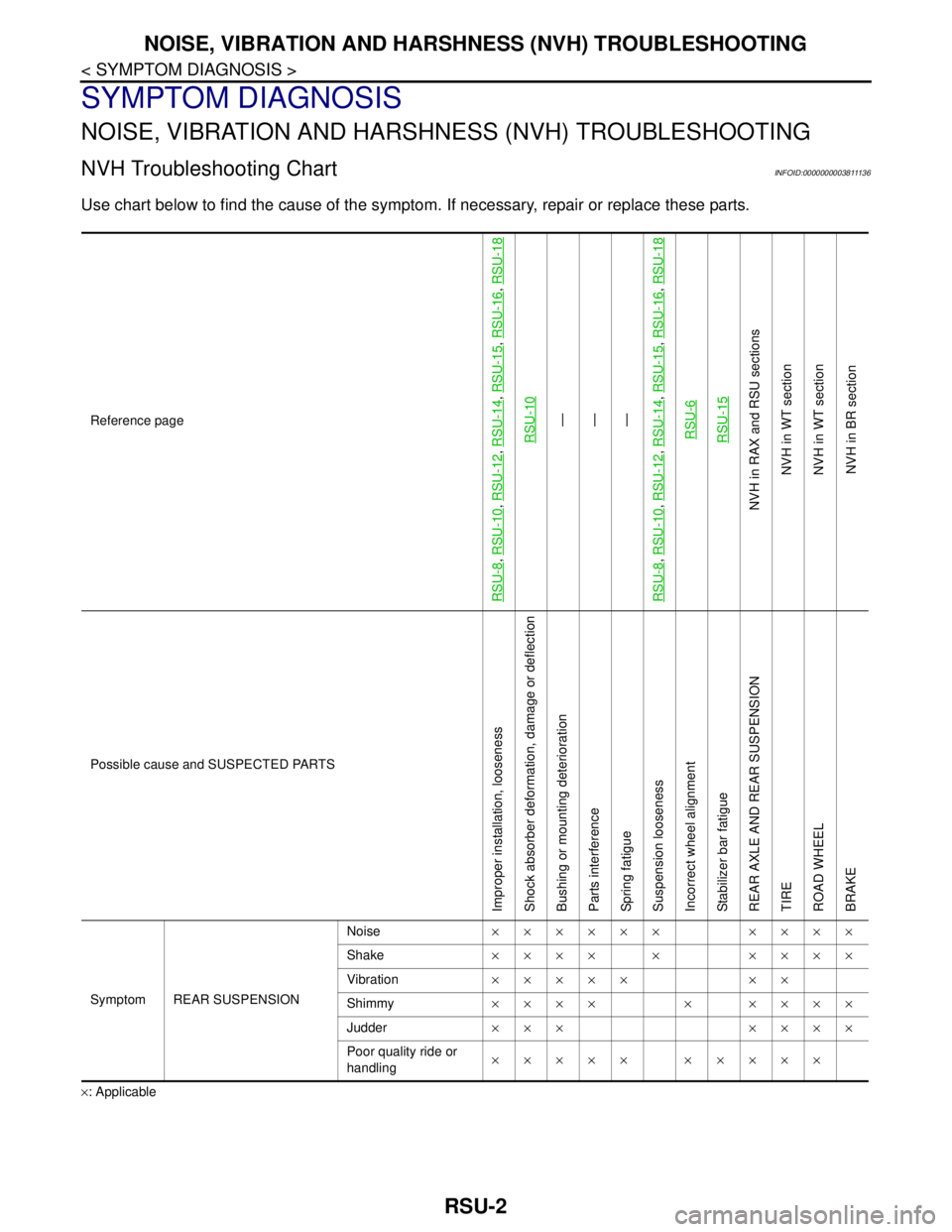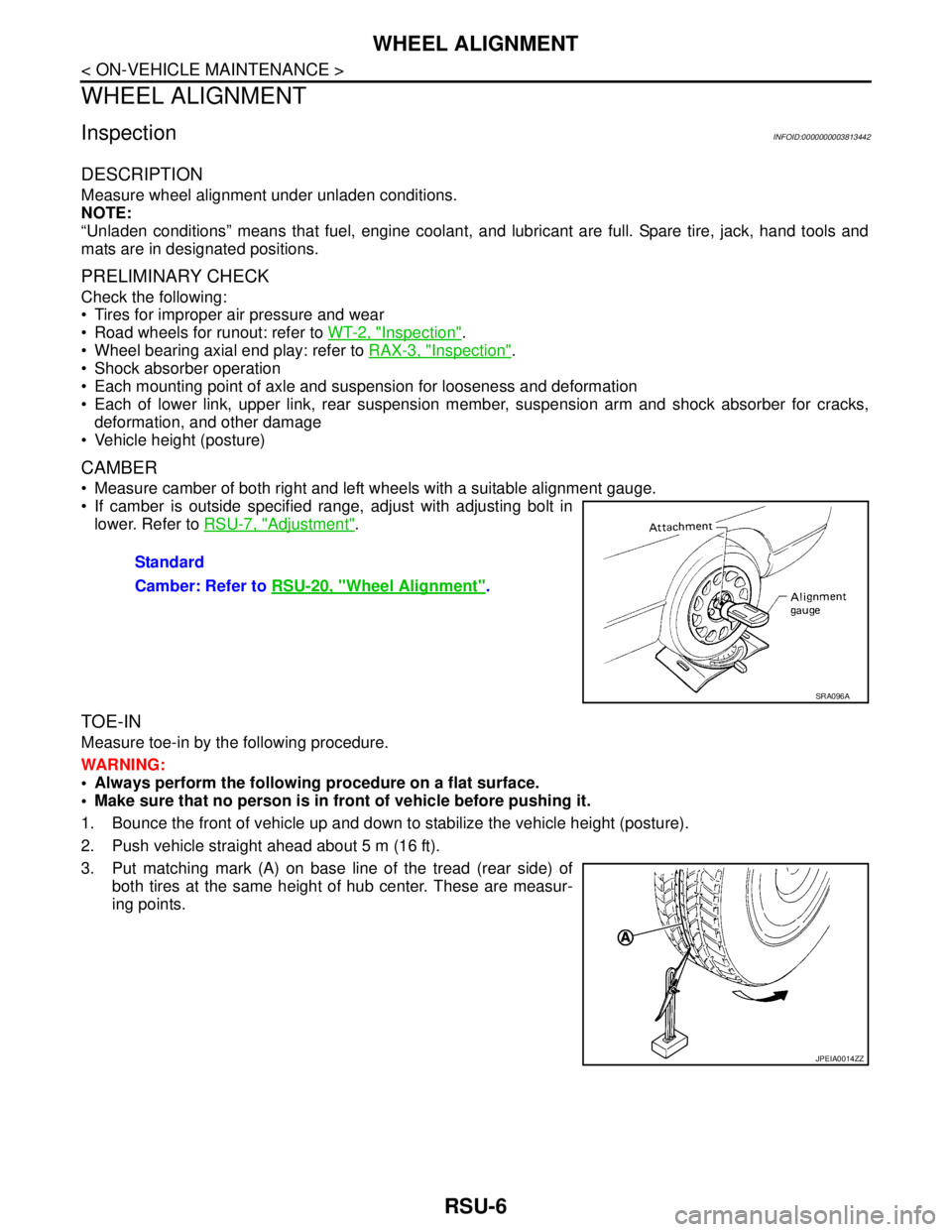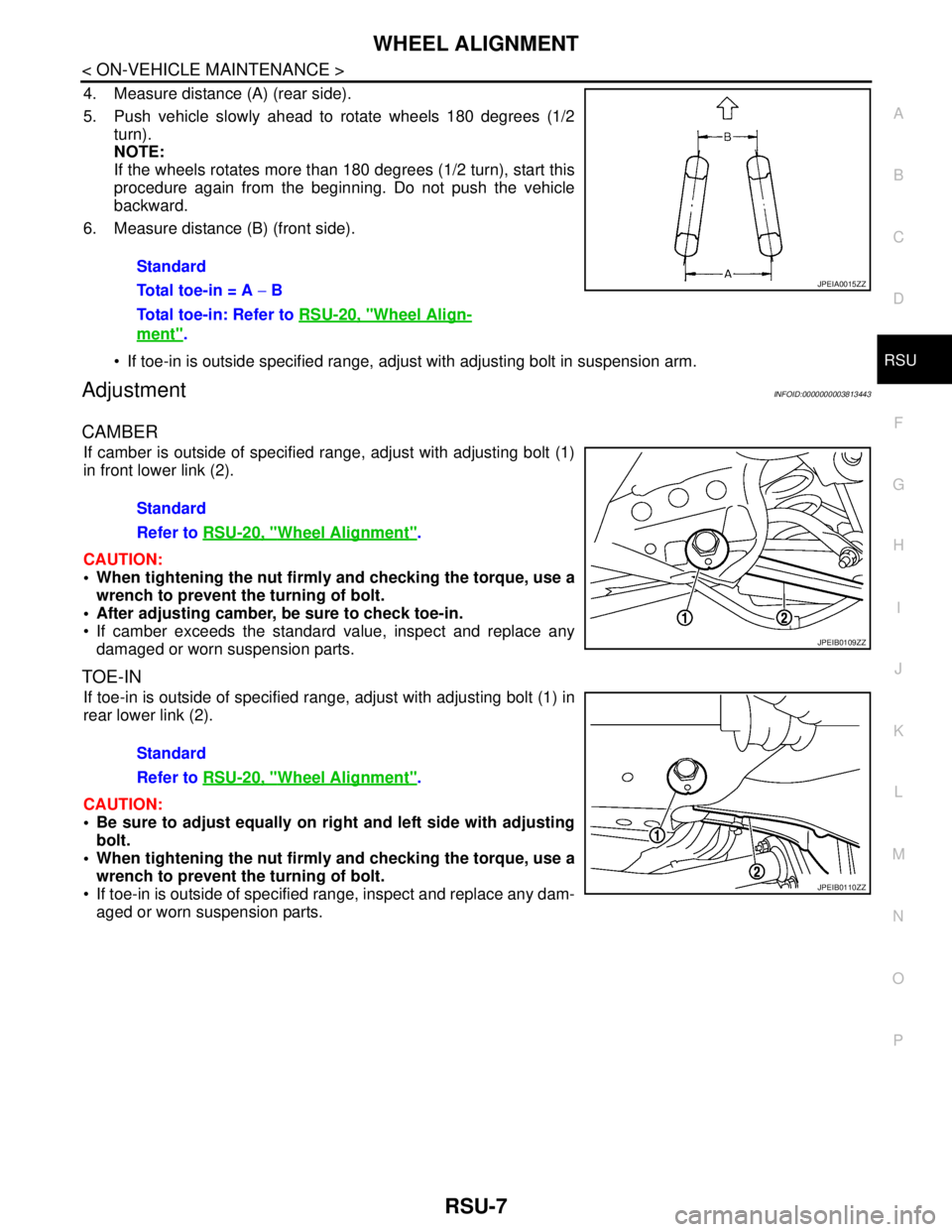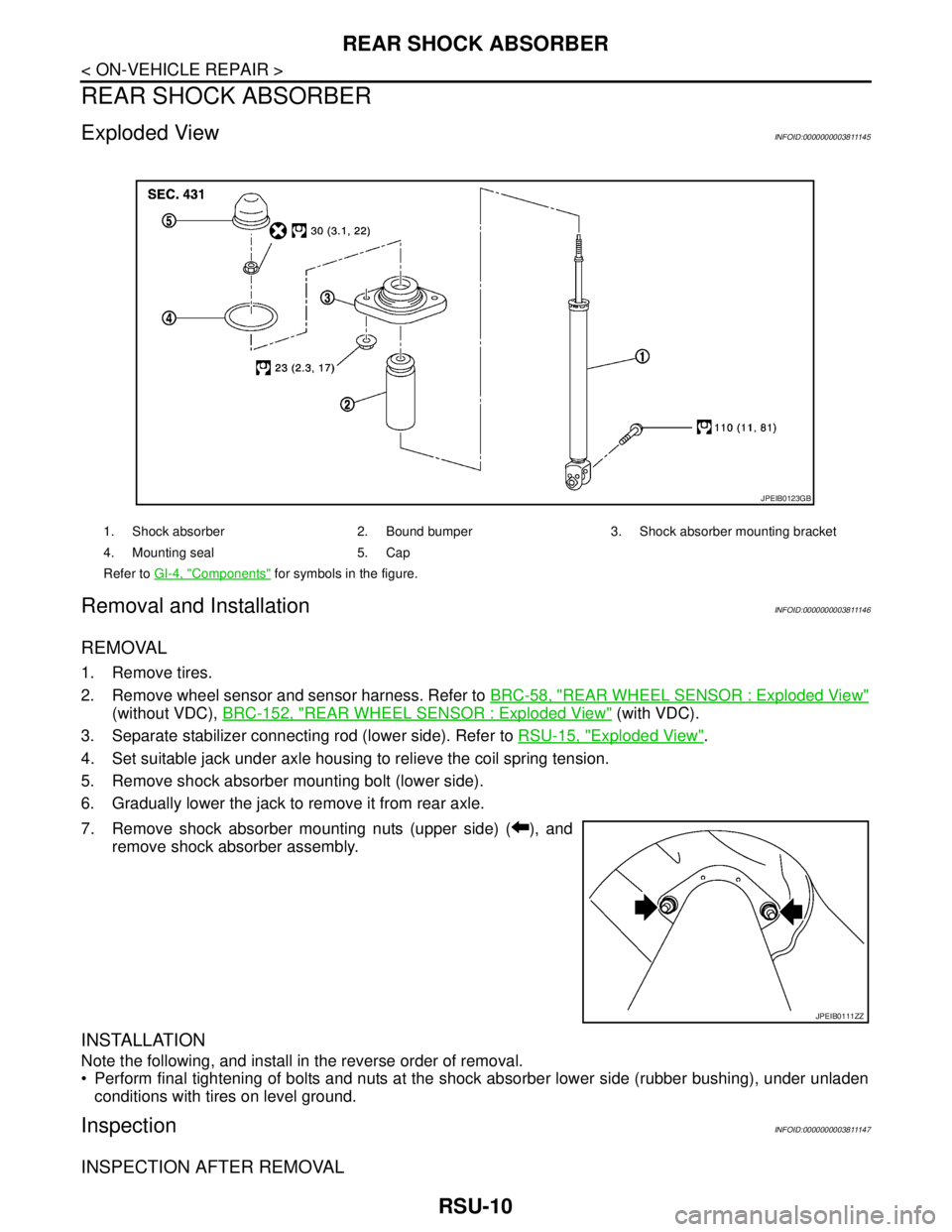Page 3834 of 5121

RSU-2
< SYMPTOM DIAGNOSIS >
NOISE, VIBRATION AND HARSHNESS (NVH) TROUBLESHOOTING
SYMPTOM DIAGNOSIS
NOISE, VIBRATION AND HARSHNESS (NVH) TROUBLESHOOTING
NVH Troubleshooting ChartINFOID:0000000003811136
Use chart below to find the cause of the symptom. If necessary, repair or replace these parts.
×: ApplicableReference page
RSU-8
, RSU-10
, RSU-12
, RSU-14
, RSU-15
, RSU-16
, RSU-18
RSU-10
—
—
—
RSU-8
, RSU-10
, RSU-12
, RSU-14
, RSU-15
, RSU-16
, RSU-18
RSU-6RSU-15
NVH in RAX and RSU sections
NVH in WT section
NVH in WT section
NVH in BR section
Possible cause and SUSPECTED PARTS
Improper installation, looseness
Shock absorber deformation, damage or deflection
Bushing or mounting deterioration
Parts interference
Spring fatigue
Suspension looseness
Incorrect wheel alignment
Stabilizer bar fatigue
REAR AXLE AND REAR SUSPENSION
TIRE
ROAD WHEEL
BRAKE
Symptom REAR SUSPENSIONNoise×××××× ××××
Shake×××× × ××××
Vibration××××× ××
Shimmy×××× × ××××
Judder ××× ××××
Poor quality ride or
handling××××× ×××××
Page 3835 of 5121
PRECAUTIONS
RSU-3
< PRECAUTION >
C
D
F
G
H
I
J
K
L
MA
B
RSU
N
O
P
PRECAUTION
PRECAUTIONS
Precautions for SuspensionINFOID:0000000003811137
CAUTION:
• When installing rubber bushings, the final tightening must be carried out under unladen conditions
with tires on ground. Oil might shorten the life of rubber bushings. Be sure to wipe off any spilled oil.
- Unladen conditions mean that fuel, engine coolant and lubricant are full. Spare tire, jack, hand tools
and mats are in designated positions.
After servicing suspension parts, be sure to check wheel alignment.
Self-lock nuts are not reusable. Always use new ones when installing. Since new self-lock nuts are
pre-oiled, tighten as they are.
Page 3838 of 5121

RSU-6
< ON-VEHICLE MAINTENANCE >
WHEEL ALIGNMENT
WHEEL ALIGNMENT
InspectionINFOID:0000000003813442
DESCRIPTION
Measure wheel alignment under unladen conditions.
NOTE:
“Unladen conditions” means that fuel, engine coolant, and lubricant are full. Spare tire, jack, hand tools and
mats are in designated positions.
PRELIMINARY CHECK
Check the following:
Tires for improper air pressure and wear
Road wheels for runout: refer to WT-2, "
Inspection".
Wheel bearing axial end play: refer to RAX-3, "
Inspection".
Shock absorber operation
Each mounting point of axle and suspension for looseness and deformation
Each of lower link, upper link, rear suspension member, suspension arm and shock absorber for cracks,
deformation, and other damage
Vehicle height (posture)
CAMBER
Measure camber of both right and left wheels with a suitable alignment gauge.
If camber is outside specified range, adjust with adjusting bolt in
lower. Refer to RSU-7, "
Adjustment".
TOE-IN
Measure toe-in by the following procedure.
WARNING:
Always perform the following procedure on a flat surface.
Make sure that no person is in front of vehicle before pushing it.
1. Bounce the front of vehicle up and down to stabilize the vehicle height (posture).
2. Push vehicle straight ahead about 5 m (16 ft).
3. Put matching mark (A) on base line of the tread (rear side) of
both tires at the same height of hub center. These are measur-
ing points.Standard
Camber: Refer to RSU-20, "
Wheel Alignment".
SRA096A
JPEIA0014ZZ
Page 3839 of 5121

WHEEL ALIGNMENT
RSU-7
< ON-VEHICLE MAINTENANCE >
C
D
F
G
H
I
J
K
L
MA
B
RSU
N
O
P
4. Measure distance (A) (rear side).
5. Push vehicle slowly ahead to rotate wheels 180 degrees (1/2
turn).
NOTE:
If the wheels rotates more than 180 degrees (1/2 turn), start this
procedure again from the beginning. Do not push the vehicle
backward.
6. Measure distance (B) (front side).
If toe-in is outside specified range, adjust with adjusting bolt in suspension arm.
AdjustmentINFOID:0000000003813443
CAMBER
If camber is outside of specified range, adjust with adjusting bolt (1)
in front lower link (2).
CAUTION:
When tightening the nut firmly and checking the torque, use a
wrench to prevent the turning of bolt.
After adjusting camber, be sure to check toe-in.
If camber exceeds the standard value, inspect and replace any
damaged or worn suspension parts.
TOE-IN
If toe-in is outside of specified range, adjust with adjusting bolt (1) in
rear lower link (2).
CAUTION:
Be sure to adjust equally on right and left side with adjusting
bolt.
When tightening the nut firmly and checking the torque, use a
wrench to prevent the turning of bolt.
If toe-in is outside of specified range, inspect and replace any dam-
aged or worn suspension parts.Standard
Total toe-in = A − B
Total toe-in: Refer to RSU-20, "
Wheel Align-
ment".
JPEIA0015ZZ
Standard
Refer to RSU-20, "
Wheel Alignment".
JPEIB0109ZZ
Standard
Refer to RSU-20, "
Wheel Alignment".
JPEIB0110ZZ
Page 3841 of 5121

REAR LOWER LINK & COIL SPRING
RSU-9
< ON-VEHICLE REPAIR >
C
D
F
G
H
I
J
K
L
MA
B
RSU
N
O
P
Install coil spring by aligning lower end of the coil spring to step (A)
between rubber seat (1) and rear lower link (2).
CAUTION:
Set coil spring so that its paint marks are aligned with the
positions of 3.0 turns (2 places) and 4.0 turns (1 place) or 4.0
turns (2 places) and 5.0 turns (1 place) from the bottom end of
the coil spring.
Perform the final tightening of rear suspension member and axle
installation position (rubber bushing) under unladen condition with
tires on level ground.
InspectionINFOID:0000000003811144
INSPECTION AFTER REMOVAL
Check lower link, bushing and coil spring for deformation, crack, and damage. Replace if necessary.
INSPECTION AFTER INSTALLATION
1. Check wheel alignment. Refer to RSU-6, "Inspection".
2. Adjust neutral position of steering angle sensor (with VDC). Refer to BRC-66, "
ADJUSTMENT OF
STEERING ANGLE SENSOR NEUTRAL POSITION : Special Repair Requirement".
JPEIB0122ZZ
Page 3842 of 5121

RSU-10
< ON-VEHICLE REPAIR >
REAR SHOCK ABSORBER
REAR SHOCK ABSORBER
Exploded ViewINFOID:0000000003811145
Removal and InstallationINFOID:0000000003811146
REMOVAL
1. Remove tires.
2. Remove wheel sensor and sensor harness. Refer to BRC-58, "
REAR WHEEL SENSOR : Exploded View"
(without VDC), BRC-152, "REAR WHEEL SENSOR : Exploded View" (with VDC).
3. Separate stabilizer connecting rod (lower side). Refer to RSU-15, "
Exploded View".
4. Set suitable jack under axle housing to relieve the coil spring tension.
5. Remove shock absorber mounting bolt (lower side).
6. Gradually lower the jack to remove it from rear axle.
7. Remove shock absorber mounting nuts (upper side) ( ), and
remove shock absorber assembly.
INSTALLATION
Note the following, and install in the reverse order of removal.
Perform final tightening of bolts and nuts at the shock absorber lower side (rubber bushing), under unladen
conditions with tires on level ground.
InspectionINFOID:0000000003811147
INSPECTION AFTER REMOVAL
1. Shock absorber 2. Bound bumper 3. Shock absorber mounting bracket
4. Mounting seal 5. Cap
Refer to GI-4, "
Components" for symbols in the figure.
JPEIB0123GB
JPEIB0111ZZ
Page 3843 of 5121
REAR SHOCK ABSORBER
RSU-11
< ON-VEHICLE REPAIR >
C
D
F
G
H
I
J
K
L
MA
B
RSU
N
O
P
Check the following items, and replace the if necessary.
Shock absorber for deformation, cracks, damage.
Welded and sealed areas for oil leakage.
Piston rod for damage, uneven wear or distortion.
Seal of shock absorber mounting bracket for cracks, damage and come off.
INSPECTION AFTER INSTALLATION
Check wheel sensor harness for proper connection. Refer to BRC-58, "REAR WHEEL SENSOR : Exploded
View" (without VDC), BRC-152, "REAR WHEEL SENSOR : Exploded View" (with VDC).
Page 3844 of 5121

RSU-12
< ON-VEHICLE REPAIR >
RADIUS ROD
RADIUS ROD
Exploded ViewINFOID:0000000003811148
Removal and InstallationINFOID:0000000003811149
REMOVAL
1. Remove tire.
2. Remove wheel sensor and sensor harness. Refer to BRC-58, "
REAR WHEEL SENSOR : Exploded View"
(without VDC), BRC-152, "REAR WHEEL SENSOR : Exploded View" (with VDC).
3. Remove rear lower link and coil spring. Refer to RSU-8, "
Exploded View".
4. Remove shock absorber mounting bolt (lower side). Refer to RSU-10, "
Exploded View".
5. Remove front lower link mounting bolt and nut (axle housing side). Refer to RSU-14, "
Exploded View".
6. Loosen front lower link mounting bolt and nut (suspension member side). Refer to RSU-14, "
Exploded
View".
7. Remove radius rod mounting bolts and nuts (axle housing side).
8. Remove radius rod mounting bolt (rear suspension member side), and then remove radius rod.
INSTALLATION
Note the following, and install in the reverse order of removal.
Perform final tightening of rear suspension member and axle installation position (rubber bushing), under
unladen conditions with tires on level ground.
InspectionINFOID:0000000003811150
INSPECTION AFTER REMOVAL
Check radius rod and bushing for any deformation, cracks, or damage. Replace if necessary.
INSPECTION AFTER INSTALLATION
1. Check wheel sensor harness for proper connection. Refer to BRC-58, "REAR WHEEL SENSOR :
Exploded View" (without VDC), BRC-152, "REAR WHEEL SENSOR : Exploded View" (with VDC).
2. Check wheel alignment. Refer to RSU-6, "
Inspection".
1. Upper seat 2. Coil spring 3. Rubber seat
4. Rear lower link 5. Rear suspension member 6. Radius rod
7. Front lower link
Refer to GI-4, "
Components" for symbols in the figure.
JPEIB0108GB